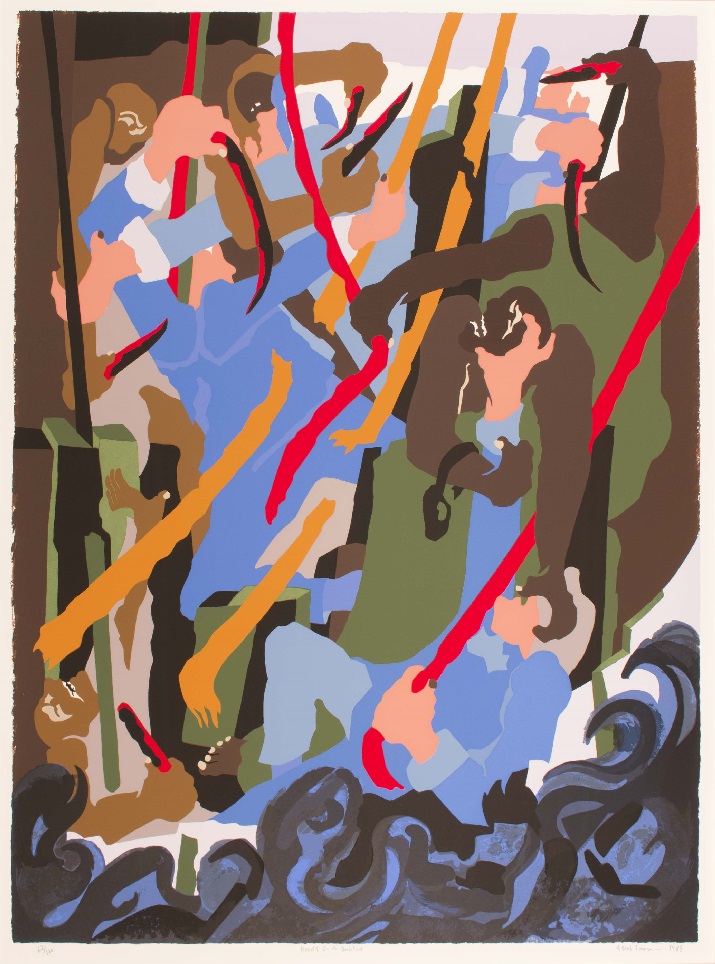
Jacob Lawrence (American, 1917-2000), Revolt on the Amistad, 1989, Silkscreen, 35 x 25 3/8 in. Museum Purchased from the Wally Findlay Acquisition Fund, 1995.26., © 2020 Jacob Lawrence/Artist Rights Society (ARS), New York
A group of massed, twisting figures, rendered in bright, even color, struggle desperately in a tight, even claustrophobic space, the threatening black-and-blue waters of the ocean lapping from the bottom of the frame. At first glance this picture seems to approach full abstraction, but as one spends more time looking at it definite forms begin to emerge. A group of figures—some with dark skin and others with light—are engaged in a desperate struggle, clawing at one another’s eyes, and plunging at one another with bloody knives. A broken piece of shackle hangs from the forearm of a Black man in the center of the composition as he fights desperately with a White man who clings to a rope. The twisting violence of the scene is made even more shocking in the light of the sinuous beauty of the forms.
The story depicted in this print, a silkscreen by the American artist Jacob Lawrence and his collaborator the master printmaker Lou Stovall, is one of the most celebrated in American history. The print, as its title makes clear, depicts the famous revolt of the enslaved people on the Spanish ship La Amistad. Sengbe Pieh (often known as Joseph Cinque) a Mende man who was one of several dozen captives on the ship bound for Cuba, freed his fellow slaves and commandeered the ship, instructing his erstwhile captors to return to Africa. The Spaniards set sail for the mainland of the United States instead, confident that they would be vindicated in their claim to ownership of the Africans in the United States, where slavery was legal. The cause of the Mende people became a national cause célèbre, with the United States Supreme Court ruling in 1841 that the Africans were free, due to the fact that their capture was not legal under United States law. United States v. Amistad, as the case was known at the Supreme Court, became a rallying cry for the increasingly influential American abolitionist movement, and held particular significance for African Americans, both free and enslaved.
Lawrence has long been known as one of the foremost artists of the Harlem Renaissance. His series depicting important figures and events in Black history, including Toussaint L’Ouverture, Harriet Tubman, John Brown, and the Great Migration, are accompanied by didactic captions in clear, straightforward English, reflecting his desire to create art which would speak to the experiences and history of all Black people in the United States. He has been underappreciated, however, as one of America’s foremost modern artists of any race. Revolt on the Amistad, which was made late in his long and prolific career, shows his absolute mastery of the forms and techniques of modernism. The tight, swirling forms of the print, as well as its shallow depth of field and exacting use of flat planes of color, are the apotheosis of Lawrence’s style, which was heavily influenced by Fauvism, Cubism, and other modernist styles. His use of color in this and other works rivals that of Matisse and other masters, and Revolt on the Amistad’s evocation of the grim horrors of history and the necessity of struggle are reminiscent of Picasso’s Guernica.
Grant Hamming, Ph.D.
American Art Research Fellow
To read more on this work by Jacob Lawrence, visit our Collection page.
View Lawrence’s Harlem Scene (The Butcher Shop) here.
